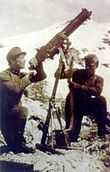M1867 Werndl-Holub
| M1867 Werndl-Holub | |
|---|---|
 | |
| Type | Service rifle |
| Place of origin |
|
| Service history | |
| In service | 1867 – 1918 |
| Used by |
Austria-Hungary Montenegro Persia Argentina (limited use) |
| Wars |
Herzegovina Uprising (1882) Balkan Wars World War I (limited)[1] |
| Production history | |
| Designer | Josef Werndl and Karel Holub |
| Designed | 1860s |
| Manufacturer | Steyr |
| Produced | 1867 - 1888 |
| Number built | 500,000 (approx.) |
| Variants |
M1873 M67/77 M73/77 Extra-Corps Carbine Finance-Gewehr Carbine Cavalry Carbine |
| Specifications | |
| Weight | 9.65 lb (4.4 kg) |
| Length | 50.4 in (128.0 cm) |
| Barrel length | 33.3 in (84.6 cm) |
|
| |
| Cartridge |
11.15x42R (M1867) 11x58mmR (1877 Upgrade) |
| Caliber | 11.15mm |
| Action | Rotating drum bolt |
| Feed system | Single-shot breech-loading |
| Sights | Iron sights |

The M1867 Werndl-Holub was a single-shot breechloading rifle that the Austro-Hungarian army adopted in 1867. It replaced the Wanzl breechloader-conversion of the muzzle-loading Lorenz rifle. Josef Werndl (1831-1889) and Karel Holub (1830-1903) designed and patented their design; Werndl later bought out all the rights.
OEWG (Österreichische Waffenfabriksgesellschaft) produced the Werndl and chambered it for the 11mm scharfe Patrone M.67 [1] (11.15x42R) cartridge. In 1877 the military rechambered the Werndl for the bottleneck 11mm scharfe Patrone M.77 (11.15x58mmR) cartridge.
In spite of the Werndl being long obsolete by World War I, the Austro-Hungarian forces issued Werndl rifles to rear-echelon units to free up more modern rifles for use by front-line troops.[1]
See also
- Weapons of the Austro-Hungarian Empire
- Mannlicher M1886 - the next Austro-Hungarian service rifle
References
| ||||||||||||||||||||||||
| ||||||||||||||||||||||||||||
